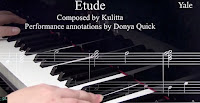 |
| Note the VCS3 synth on top of the organ |
The keys are pretty buried in the song (although the sequenced synth carries it), so it's pretty interesting to hear just how intricate they are.
1. Listen to how the sequenced synth constantly changes throughout the song in both feel and timbre. This was supplied by Townshend's favorite: the EMS VCS3 (see the picture on the left). Unlike the way most sequencers are used in the studio, Pete Townshend's approach was totally unique in that a sequence never seems to repeat and it carries the rhythm of the song.
2. Likewise, the keys (electric piano and organ) also change with the different sections of the song. They're pretty loose parts in that you'll hear some mistakes (like the second verse around the 2 minute mark) here that you won't hear on the final mix.
3. The song is built around a primitive rhythm machine with is very apparent at the very beginning of the song, but fades into the keyboard mix to where you only hear the kick sound.






